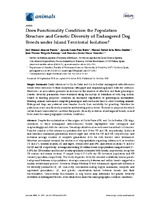| dc.contributor.author | Alanzor Puente, José Manuel | |
| dc.contributor.author | Pons Barro, Águeda Laura | |
| dc.contributor.author | Haba Giraldo, M.R. de la | |
| dc.contributor.author | Delgado-Bermejo, J.V. | |
| dc.contributor.author | Navas González, Francisco Javier | |
| dc.date.accessioned | 2020-10-16T12:12:41Z | |
| dc.date.available | 2020-10-16T12:12:41Z | |
| dc.date.issued | 2020 | |
| dc.identifier.uri | http://hdl.handle.net/10396/20523 | |
| dc.description.abstract | Despite the undefinition of the origins of Ca de Rater (CR) and Ca de Bestiar (CB) dogs, references to these endangered autochthonous breeds highlighted their ratting/pet and shepherding/guard skills for centuries. Genealogical historical records were traced back to founders. Founder number in the reference population (146 and 53 for CR and CB, respectively), historical and reference maximum generations traced (eight and seven for CR and CB, respectively), and historical average number of complete generations (1.04 for both breeds) were determined. Structure assessment revealed the existence of subpopulations regarding criteria such as breeders (75 and 17), breeder location (32 and eight), owners (368 and 198), and owner location (73 and 51) for CR and CB, respectively. Average inbreeding (F) within breed subpopulations ranged from 0.27–1.20% for CB breeders and the rest of subpopulation criteria for both breeds, respectively, except for CB owners and owner location. F ranged from 0.27–1.41% for CB historical population and CR current population, respectively. The study of genetic diversity revealed a relatively similar genetic background between subpopulations. Average coancestry between and within breeds suggested a similar evolutionary process. However, Mann–Whitney U test determined significant differences for diversity parameters (F, ΔR, coancestry, nonrandom mating degree, maximum, complete, and equivalent generations, ΔF, and genetic conservation index) between breeds and their functionalities. Conclusively, functionality in dog breeds may determine the genetic diversity evolution of endangered breeds, even when these share the same geographic isolation conditions. | es_ES |
| dc.format.mimetype | application/pdf | es_ES |
| dc.language.iso | eng | es_ES |
| dc.publisher | MDPI | es_ES |
| dc.rights | https://creativecommons.org/licenses/by/4.0/ | es_ES |
| dc.source | Animals 10(10), 1893 (2020) | es_ES |
| dc.subject | Ratting and hunting | es_ES |
| dc.subject | Guard and shepherding | es_ES |
| dc.subject | Functionality | es_ES |
| dc.subject | Conservation strategies | es_ES |
| dc.subject | Pedigree-based assessment | es_ES |
| dc.subject | Population structure | es_ES |
| dc.title | Does Functionality Condition the Population Structure and Genetic Diversity of Endangered Dog Breeds under Island Territorial Isolation? | es_ES |
| dc.type | info:eu-repo/semantics/article | es_ES |
| dc.relation.publisherversion | http://dx.doi.org/10.3390/ani10101893 | es_ES |
| dc.rights.accessRights | info:eu-repo/semantics/openAccess | es_ES |

